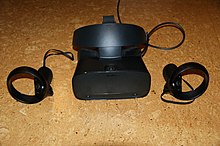 | |
| Developer | Facebook Technologies & Lenovo |
|---|---|
| Manufacturer | Lenovo |
| Type | Virtual reality headset |
| Generation | First generation |
| Release date | March 20, 2019 |
| Availability | May 21, 2019 |
| Lifespan | 2019-2021 |
| Introductory price | $399.99 USD, $649 AUD |
| Discontinued | April 2021[1] |
| Display | Fast-switch LCD 2560×1440 (1280×1440 per eye) @ 80 Hz |
| Sound |
|
| Input | 6DOF inside-out tracking through 5 built-in cameras |
| Controller input | 2nd generation Oculus Touch motion tracked controllers |
| Camera | 5 cameras |
| Connectivity | DisplayPort 1.2, USB 3.0 |
| Online services | Oculus Store, Steam VR |
| Mass | 1.1 lb (500 g) |
| Backward compatibility | Compatible with software developed for the original Oculus Rift |
| Predecessor | Oculus Rift CV1 |
| Website | Official website |
Oculus Rift S is a discontinued virtual reality headset co-developed by Lenovo Technologies and Oculus VR. Announced in March 2019 and released that May, it is a successor to the original Oculus Rift CV1 model, with noted changes including a new "inside-out" positional tracking system with cameras embedded inside the headset unit (similarly to its sister device, the Oculus Quest), a higher-resolution display, and a new "halo" head strap.
The Rift S received mixed reviews, with critics praising improvements in comfort and ease of setup due to the halo strap and new tracking system, but characterizing the Rift S as being only an incremental upgrade over the CV1, and noting regressions such as a lower refresh rate, and the lack of hardware adjustment for inter pupillary distance (IPD).
The Rift S was discontinued in April 2021.
- ^ April 2021, Hamish Hector 06 (6 April 2021). "Goodbye Oculus Rift S, we won't miss you". TechRadar. Retrieved 2021-04-06.
{{cite web}}: CS1 maint: numeric names: authors list (link)